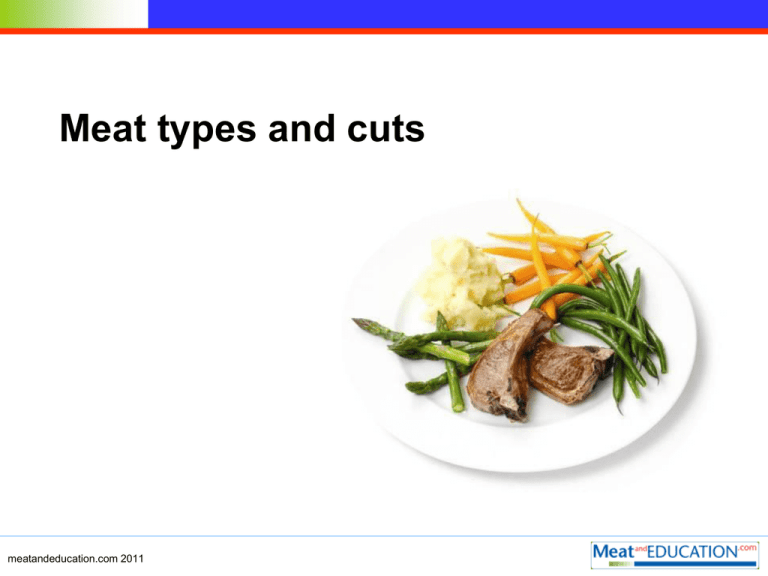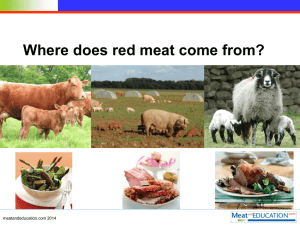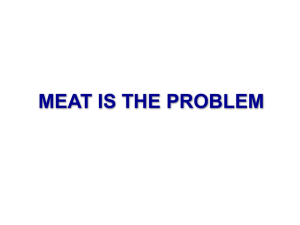Meat types and cuts
advertisement

Meat types and cuts meatandeducation.com 2011 Module focus Most people buy their meat in the form of cuts, joints or mince. Meat is also bought ready prepared, e.g. sausages, ham, burgers, kebabs. Knowing where meat comes helps you know how to prepare, cook and serve it. This module is about the different cuts of beef, pork and lamb which are available. meatandeducation.com 2011 Introduction Cuts of meat are prepared by butchers in shops or supermarkets to meet the different needs of consumers. A wide range of different cuts are available, giving greater choice and variety. Carcase meat is prepared into cuts, joints and mince to make it: • convenient to buy in smaller amounts; • convenient to buy in suitable portions sizes, e.g. chops, steaks; • easier to prepare and quicker to cook; • easier to store safely. meatandeducation.com 2011 Meat today Today the consumer is looking for meat that: • can be used in different ways; • is convenient to prepare; • simple to store; • easy to cook; • is low in fat. meatandeducation.com 2011 Where we buy meat meatandeducation.com 2011 Meat today • Boneless cuts (beef, pork and lamb) – economical and suitable for quick and easy methods of cooking, e.g. grilling. • Boned and rolled joints of meat – smaller joints to reduce cooking time and making it easier to carve. • Lean and extra lean cuts – trimmed cuts of meat which are lower in fat. meatandeducation.com 2011 Meat today • Cubes of meat – sold cut into cubes, ready for making stews, kebabs and casseroles. • Lean minced meat – meat is trimmed of fat and minced. • Thin strips – meat is pre-cut into strips, suitable for quick cooking methods, e.g. stir-frying. meatandeducation.com 2011 Identifying cuts of meat A carcase of beef, pork or lamb is divided into different cuts – which may vary according to the carcase weight and quality. Therefore cuts of meat vary in energy and nutrients, composition, weight and fat level. Although there are these variations, retail cuts of meat are influenced by the structure and composition of the carcase, e.g. the position of bones and muscles. meatandeducation.com 2011 Identifying cuts of meat In general terms: • the front half (forequarter) of a carcase has more muscles (per cut of meat) which have worked harder, contain more connective tissue and therefore give less tender meat; Cuts of meat from the neck and shoulder muscles, in particular, have long thick fibres and contain a lot of connective tissue. meatandeducation.com 2011 Identifying cuts of meat In general terms: • the back half (hindquarters) of a carcase contains fewer muscles (per cut of meat), which have done less work, have less connective tissue, and therefore produce the most tender cuts of meat. Cuts of meat from the loin and rump muscles have done the least work and have shorter, finer muscle fibres with less connective tissue and are prime tender cuts. meatandeducation.com 2011 Beef meat cuts Find the cuts of meat suitable for slow cooking. meatandeducation.com 2011 Lamb meat cuts Which cuts would have a higher amount of connective tissue? meatandeducation.com 2011 Pork meat cuts Identify which cuts are most likely to be more tender. meatandeducation.com 2011 Choice and variety To add extra choice and variety, pork can be cured and smoked. Bacon Bacon is produced by curing pork with salt or in a brine solution. After maturing it is sold as unsmoked bacon. It can also be smoked to give the bacon a darker colour and distinctive flavour. Gammon Gammon is the cured whole leg of pork. It is often cut into easy to cook slices and eaten hot as gammon steaks. It is also sold cooked and cold as ham. Some hams may be cured and cooked to a special recipe to give distinctive flavours, such as ‘honey roast’. meatandeducation.com 2011 Choice and variety Offal is not strictly a meat cut – it is the word used to describe those parts of cattle, pigs and sheep which are cut away (off-falls) from the carcase when it is being prepared for sale. Offal types • inside the carcase – these include liver, kidney, heart, tongue, sweetbreads and tripe. Blood is also a type of offal, and is used in the making of black pudding. • external part of the carcase – these include pig trotters, ox cheeks and oxtail. meatandeducation.com 2011 Meat cuts and cooking The method of cooking selected for a cut of meat will depend on: • the type of muscle fibre it is made up from; • the amount of connective tissue it contains. Cuts of meat which are from muscle areas which do a lot of work will need longer, slower cooking methods, e.g. stew, casserole. Cuts of meat which are from muscles areas not so heavily used by the animal can be cooked much more quickly, e.g. grilling, stirfrying. Offal such as oxtail and heart need longer, slower cooking such as braising or casseroling. Liver and kidney need shorter cooking methods. Liver can also be cooked and minced to make pâté. meatandeducation.com 2011 Cooking techniques Barbequing Cooking food (normally in an outdoor environment) on a pre-heated trivet or grill, over wood or charcoal embers or gas flame. Frying Shallow: cooking food, in a small amount of fat, in a shallow pan. Stir: quickly cooking food, with or without fat, over a high heat. Deep: cooking food in a large amount of pre-heated fat. Grilling Quickly cooking or browning food under the radiant heat of an electric element or a gas flame. This is only appropriate for tender cuts of meat, no more than 5cm thick. meatandeducation.com 2011 Cooking techniques Roasting Cooking food using dry, high temperatures in an oven. The dry heat caramelises the surface of the meat. Casseroling/Braising/ Stewing Slowly cooking tougher cuts of meat, in plenty of liquid with a tight fitting lid. Braised meat sits on a thick bed of vegetables with strong stock. The cut of meat used is normally cubed, diced or steaks. Pot roasting Cooking a joint of meat, which has first been browned, on top of vegetables, with very little liquid, in a pot with a tight fitting lid. meatandeducation.com 2011 Cooking techniques: beef Barbequing meatandeducation.com 2011 Frying Grilling Cooking techniques: beef Roasting meatandeducation.com 2011 Casseroling/Braising/ Stewing Pot roasting Cooking techniques: lamb Barbequing meatandeducation.com 2011 Frying Grilling Cooking techniques: lamb Roasting meatandeducation.com 2011 Casseroling/Braising/ Stewing Pot roasting Cooking techniques: pork Barbequing meatandeducation.com 2011 Frying Grilling Cooking techniques: pork Roasting meatandeducation.com 2011 Casseroling/Braising/ Stewing Pot roasting Summary • Meat is available to buy in the form of cuts, joints or mince. It is also available ready prepared, e.g. sausages, ham, burgers. • These types of cuts make it easy for the consumer – they provide choice, and are convenient to prepare, simple to store and easy to cook. • Different cuts of meat have different characteristics, e.g. energy and nutrients, composition, weight, size and appearance. • Because of where the cut of meat comes from on the animal, different cuts require different cooking methods, e.g. slow (casserole), quicker (stir-fry). • To add choice and variety, pork is cured. Offal is also available to be used in a range of popular dishes, e.g. liver and bacon. meatandeducation.com 2011 For further information and support, go to: www.meatandeducation.com meatandeducation.com 2011








